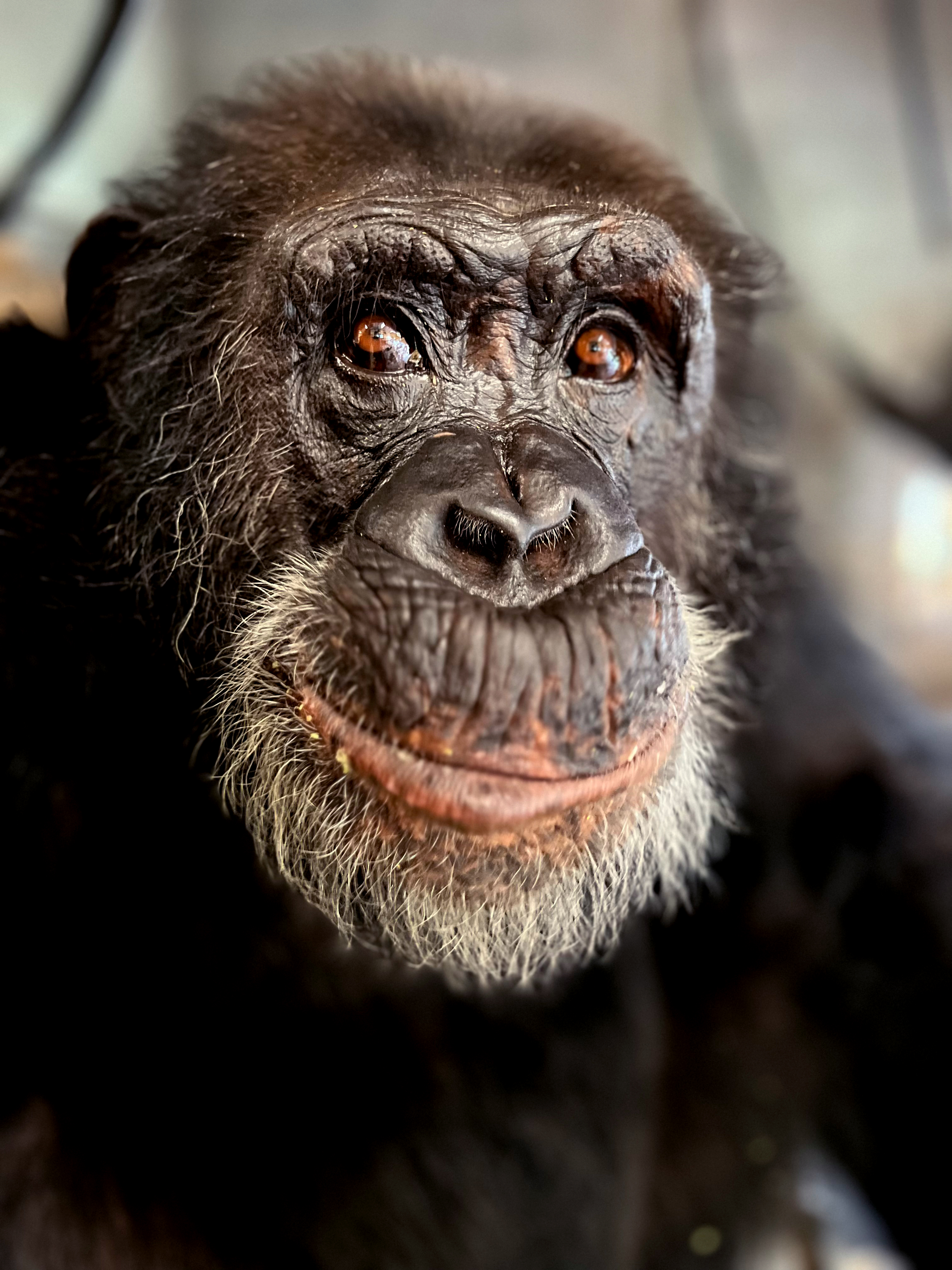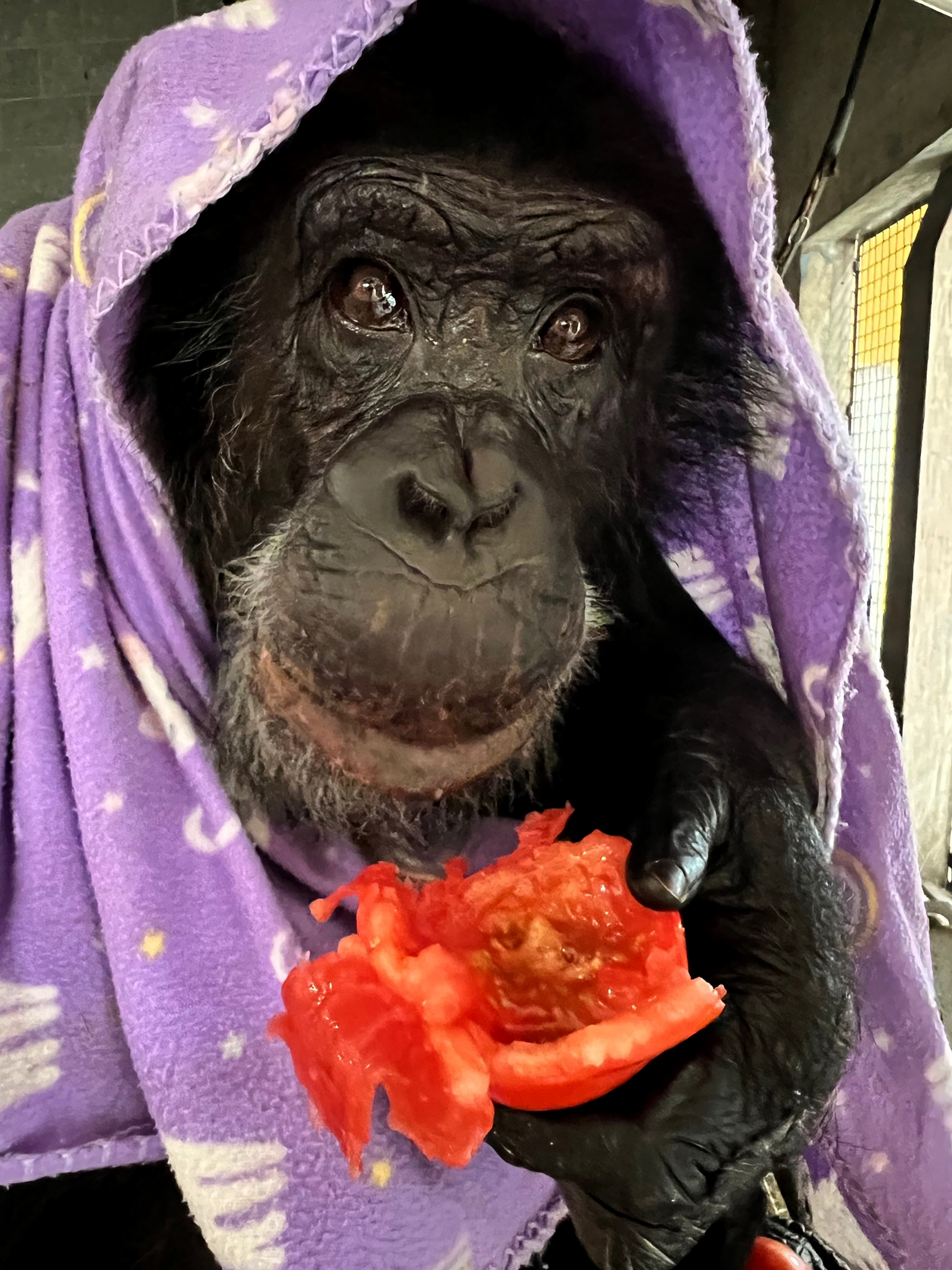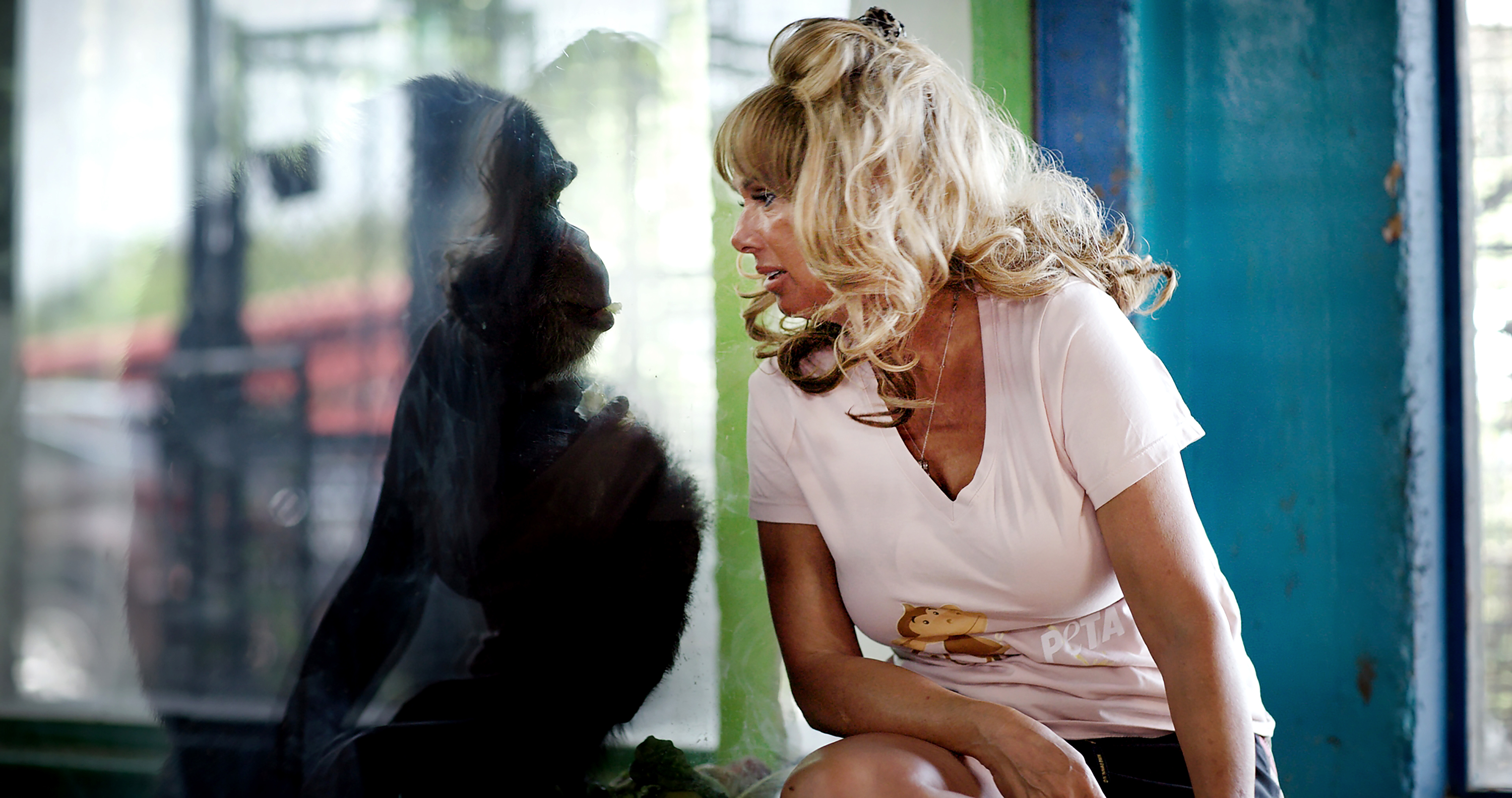
As a compassionate animal lover and primatologist who has dedicated my life to understanding and caring for these intelligent creatures, I cannot help but be deeply moved by the story of Tonka, the chimpanzee who found a new home at Save the Chimps sanctuary.
After spending almost a year confined in a basement cage, Tonka longed for some fresh air. Despite the caretakers creating a comfortable area adorned with hammocks and blankets for the chimpanzee, upon arrival at his new sanctuary on Florida’s Treasure Coast, he chose to bypass this personal room. Instead, he ventured out into the rain and remained motionless, allowing the rainwater to soak him thoroughly.
For approximately two years now, Tonka has resided at Save the Chimps, a 150-acre sanctuary on a preserved plot of land, providing a home for 222 chimpanzees who were born and raised in captivity to enjoy their golden years. As portrayed in the final episode of “Chimp Crazy,” a four-part series airing its finale this Sunday on HBO, Tonka was transferred to the Fort Pierce, Florida sanctuary following his discovery by PETA, who found him concealed within the depths of a home in Missouri by his previous owner.
The animal welfare group learned about Tonka’s location from the producers of “Chimp Crazy,” who had concerns that Tonia Haddix intended to put down the chimpanzee. Haddix informed the cameras that her local vet had diagnosed Tonka with congestive heart failure. However, when federal marshals seized Tonka from Haddix’s house on June 5, 2022, veterinarians from Save the Chimps discovered he had no significant health problems. He was overweight due to regular consumption of McDonald’s Happy Meals and pale from being kept indoors, but he was deemed healthy enough for the 23-hour journey from Missouri to Florida.

In the documentary series, Haddix frequently conveys her concern that Tonka might struggle to adapt among regular chimpanzees. Given that she often called him a “humanzee,” an ape who had acted in Hollywood movies such as “Buddy” and “George of the Jungle,” this fear seemed justified. Eventually, at the Missouri Primate Foundation, he resided in a cage with other chimps but showed more affinity towards humans, receiving food items like Powerade, French fries, and doughnuts from them.
At the Florida sanctuary, Tonka’s carers claim that he has grown accustomed and thrived while living among his fellow species.
Ana Paula Tavares, CEO of Save the Chimps, finds it remarkable how well Tonka is adjusting. “Initially, the chimps tend to be drawn to humans,” she explains, “However, when provided a chance, they consistently opt for companionship with other chimpanzees instead.
Upon his arrival, Tonka was isolated for 60 days for quarantine purposes. During this time, the primatologists from the nonprofit closely watched his actions to decide which chimpanzee family group would be suitable for him to gradually join. Out of the many island habitats available on the property, the scientists ultimately chose Doug’s Island, a 3-acre area featuring hills, climbing structures, and 16 other chimps, as the ideal location for Tonka.
At the sanctuary, we strive to offer the chimps a lifestyle that closely resembles their natural one in the wild, as explained by Tavares. This involves granting them freedom to roam freely at will and organizing them into larger social structures where they can establish their own hierarchies.
According to Tavares, it appears that Tonka hasn’t shown much enthusiasm about joining the family hierarchy. However, he has formed strong bonds with two other chimps named Jake and Cayleb. Interestingly, it was found out later that Cayleb is actually Tonka’s biological son.
Tonka with Cayleb, his biological son.
Initially, we weren’t aware that they were a father and son, but watching them leap side by side was simply breathtaking. The bond between them is astounding, it’s incredible to see how closely connected they are, she remarks.
One of Tonka’s descendants, Lisa Marie – who was cared for by an Elvis tribute artist – currently resides on a separate island within the sanctuary. Given that Tonka belonged to a chimpanzee breeder, Tavares believes there could be many offspring; his fatherhood to the two apes at Save the Chimps was confirmed through data collected from previous breeders.
At the sanctuary, all the male apes undergo vasectomies, yet this procedure doesn’t prevent them from mating.
Tavares chuckles as he mentions, ‘He’s definitely got an eye for the ladies. You could say Tonka is quite popular among them.’
Tonka running with a fellow chimp named Jacob at the sanctuary.
Instead, Tonka fills his days with a variety of activities tailored by resident primatologists to engage him physically, mentally, and emotionally. These activities include painting, playing with soap bubbles, and searching for treats such as frozen berries, green beans, and lettuce leaves.
At Save the Chimps, approximately 2,500 pounds of food is consumed daily by the entire population. This food is skillfully prepared by a chef who was once associated with Jimmy Buffett. The chimps follow a vegan diet, and their treats are not typical fast-food items. Instead, they enjoy seasonal treats like watermelons during the Fourth of July and apples coated in sugar-free caramel and nuts.
Without much effort, Tonka shed the excess weight once he started eating a diet rich in fresh fruits and veggies, while also getting plenty of sunshine and exercise in Florida, as Tavares explains. He further notes that if Tonka stays healthy, he could potentially live up to two decades longer than the average lifespan for his species in the wild.
By nightfall, the majority of chimps retreat to their indoor quarters, allowing them the freedom to choose their sleeping spot and companion. Every chimp is given fresh hay daily for constructing a complex nest before drifting off to sleep, a habit they share in their natural habitat. Although caretakers may be present indoors, the chimps maintain distance, with the closest interaction being “tickle sticks” – two-foot-long hoses that staff insert through mesh barriers to interact and play with the animals from a safe distance.

Save the Chimps is not open for general public visits, but it holds three annual events where donors can visit the premises and observe the chimps from a distance. The nonprofit relies solely on donations; caring for one chimp costs roughly $30,000 per year according to Tavares. She notes that visitors may have the opportunity to see Tonka as he is quite curious and social, but there are no promises; “We operate on chimp time.
Regarding Haddix, the CEO has not received any communication from Tonka’s previous caretaker. If Haddix wishes to inspect the property, Tavares mentions that she would confer with the in-house primatologists and make choices considering Tonka’s wellbeing.
Tavares expressed it was distressing for them to witness certain scenes of Tonka in ‘Chimp Crazy’, noticing his apparent discomfort under those harsh conditions. However, if you were to see him today, he’s remarkably serene. He appears to be thriving in the life that suits him best.
Read More
- Clash Royale Best Boss Bandit Champion decks
- Chuck Mangione, Grammy-winning jazz superstar and composer, dies at 84
- December 18 Will Be A Devastating Day For Stephen Amell Arrow Fans
- Clash Royale Furnace Evolution best decks guide
- Now That The Bear Season 4 Is Out, I’m Flashing Back To Sitcom Icons David Alan Grier And Wendi McLendon-Covey Debating Whether It’s Really A Comedy
- Clash Royale Witch Evolution best decks guide
- Riot Games announces End of Year Charity Voting campaign
- Deneme Bonusu Veren Siteler – En Gvenilir Bahis Siteleri 2025.4338
- All Soulframe Founder tiers and rewards
- BLEACH: Soul Resonance Character Tier List
2024-09-08 13:31